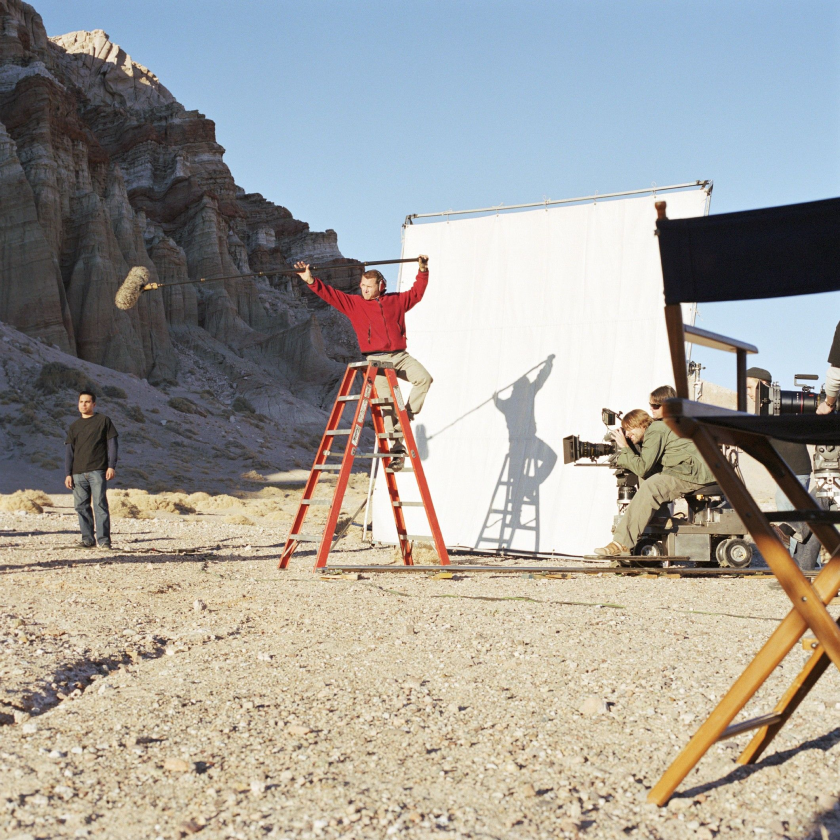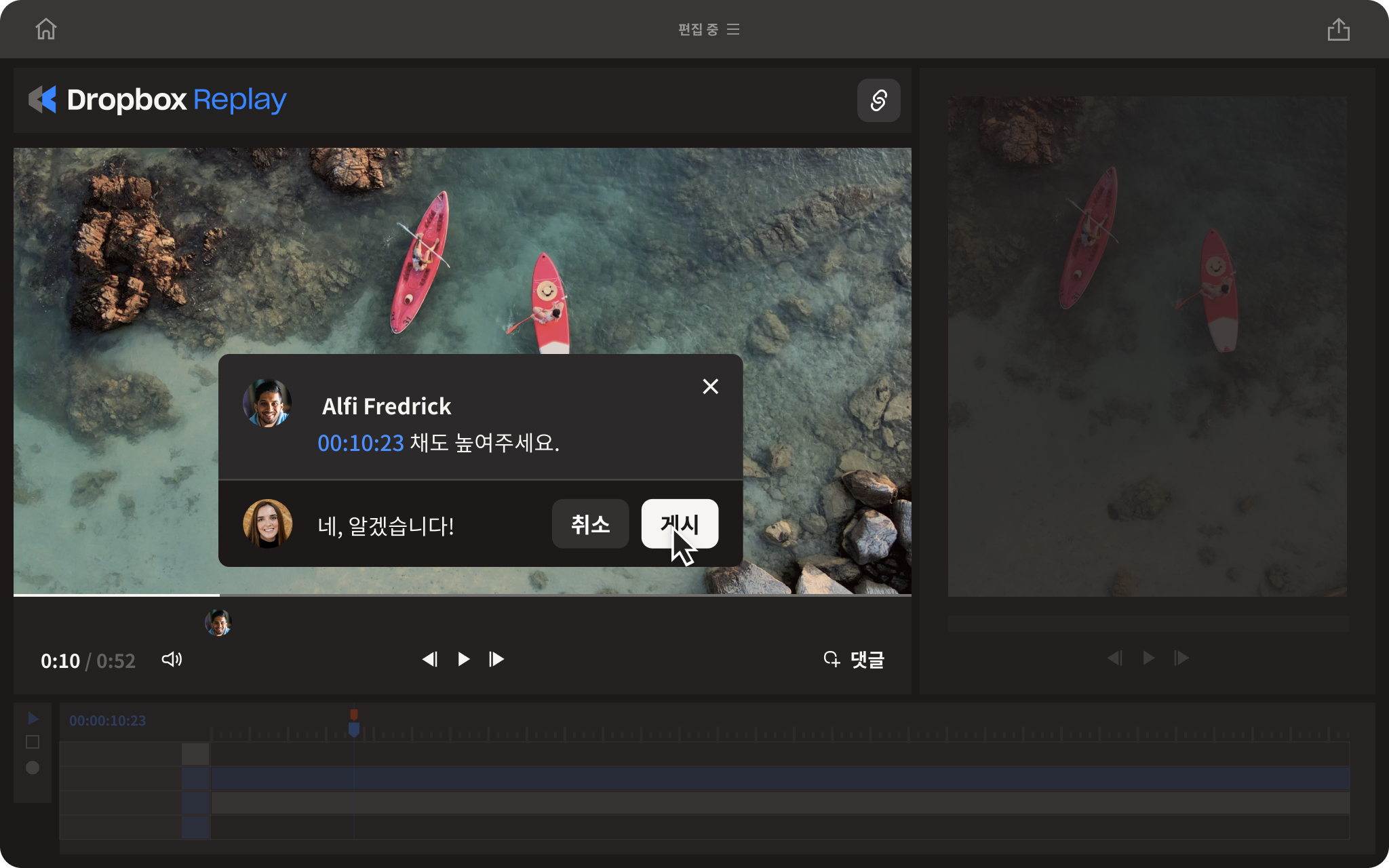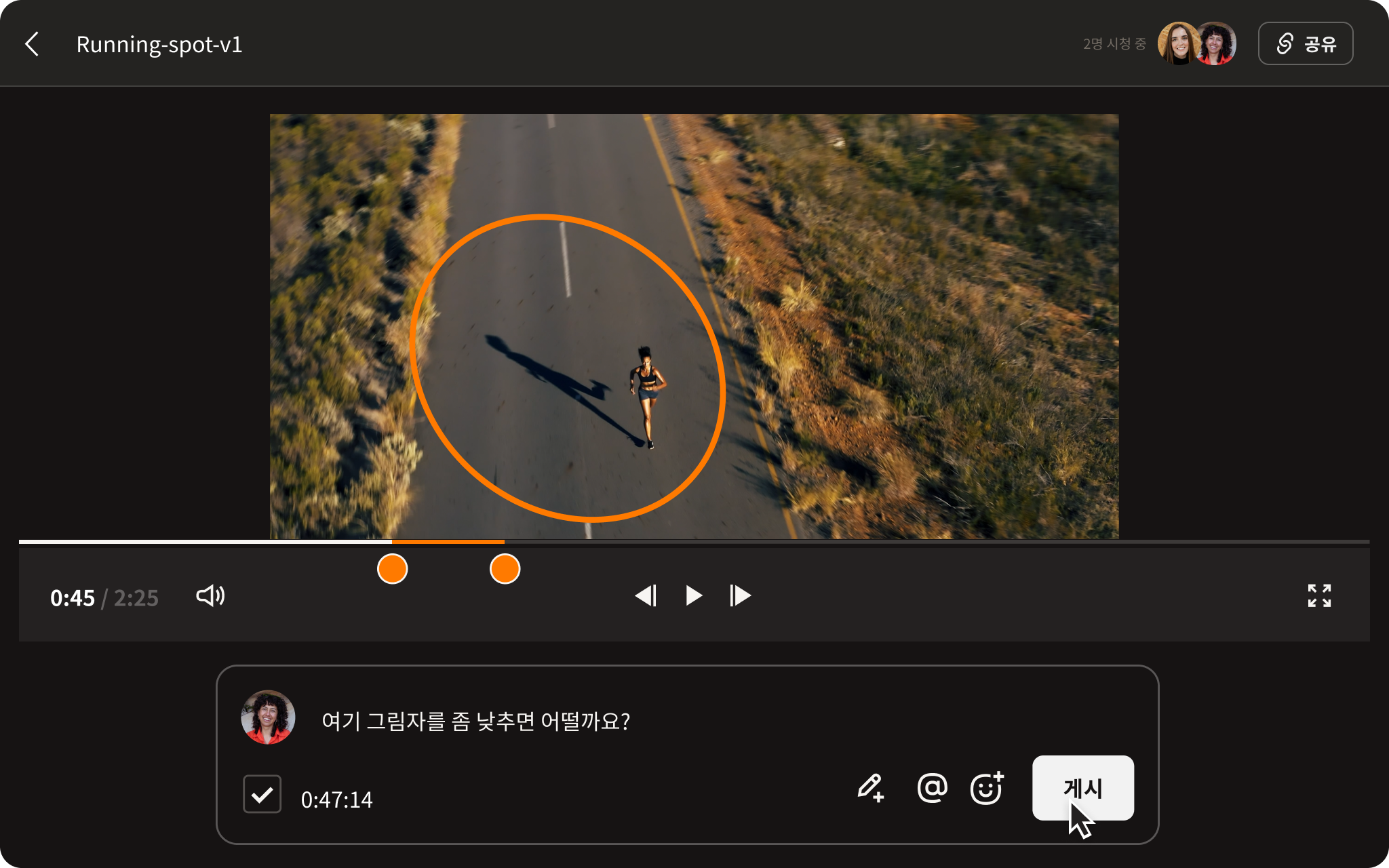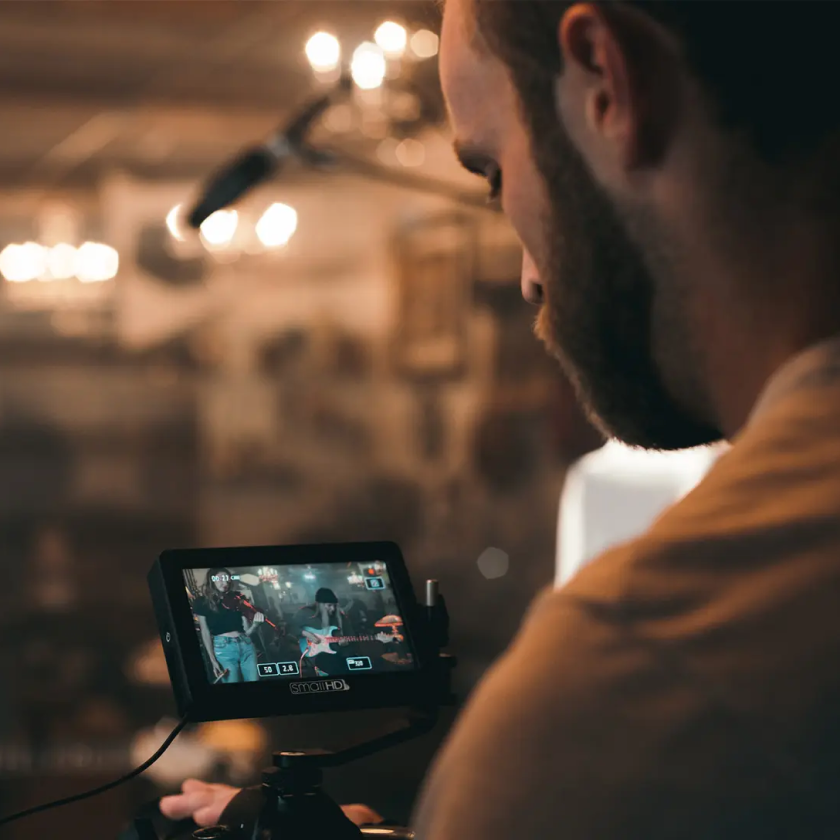인상 깊은 동영상을 제작하는 첫 번째 단계는 바로 동영상 편집 방법을 배우는 것입니다. 최근에 만든 YouTube 동영상을 마무리하든, 중요한 클라이언트를 위한 전국적인 소셜 미디어 광고를 제작하든, 팀을 위한 튜토리얼 동영상을 개발하든, 잘 편집된 동영상은 수많은 동영상 사이에서 돋보이기 마련입니다.
동영상으로 창의적인 아이디어를 구현하는 방법은 생각보다 간단합니다. 다음과 같은 단순한 동영상 편집 프로세스만 거치면 되죠.
1단계. 소프트웨어 선택
동영상을 편집하려면 계획과 준비가 필요합니다. 일반적으로는 동영상의 형식이 사용해야 하는 동영상 소프트웨어 유형에 영향을 미칩니다.
예를 들어, 휴대폰이나 태블릿으로 동영상을 촬영했다면 사용할 수 있는 동영상 편집 도구가 장치에 이미 있을 수도 있습니다. 또는, Mac에서 제공되는 iMovie처럼 컴퓨터에 탑재된 동영상 편집 앱이 있을 수도 있죠.
하지만 조금 더 정교한 편집 기능을 원한다면 Adobe Premiere Pro 같은 전문 플랫폼을 사용하는 것이 좋습니다. 그리고 동영상을 검토할 준비가 되면 이러한 도구를 Dropbox Replay와 통합해 편집 도구에 통합된 Replay에서 바로 피드백을 확인할 수 있죠.
Dropbox는 원본 동영상 파일 관리와 저장을 위한 이상적인 중심 공간입니다. 모든 것이 한 공간에 보관되어 있고 다양한 장치로 액세스할 수 있어 모바일 장치로 동영상을 촬영한 후, 편집할 준비가 되면 컴퓨터를 통해 파일에 액세스할 수 있죠.
동영상과 오디오를 가져와 정리
자료와 프로젝트 파일에 대한 계획을 제대로 세워 놓으면 편집을 진행하는 과정에서 체계성(과 온전한 정신)을 유지하는 데 도움이 됩니다.
컴퓨터에서 편집할 때는 일반적으로 폴더 시스템에서 비디오, 오디오, 이미지 파일을 끌어서 비디오 편집 소프트웨어로 가져와서 가져올 수 있습니다. 이는 편집 소프트웨어의 인터페이스와 컴퓨터 운영 체제에 따라 달라집니다. 때로는 가져오기 과정을 거치는 동안 비디오에 사용할 종횡비를 설정할 수 있습니다.
미디어 파일을 가져온 후에는 파일을 프로젝트로 끌어다 놓을 수 있습니다. 여기서 동영상 축소판 이미지를 통해 동영상을 살펴볼 수 있는데요, 소프트웨어에 미디어 파일, 편집 미리 보기 화면, 동영상 타임라인이 여러 개의 창으로 구분되어 있는 작업 공간이 표시될 겁니다.

2단계: 편집 플랫폼을 사용해 동영상 편집
동영상과 오디오를 합쳤다면 이제 조각난 부분을 하나의 스토리로 엮을 차례입니다.
동영상 편집 단계에서는 여러 개의 클립을 하나의 시퀀스로 연결하는 작업이 필요합니다. 장면 전환 효과를 사용해 클립을 연결해야 할 때도 있죠. 기본적인 무료 도구도 다양한 장면 전환 효과를 제공하며, 조금 더 전문적인 소프트웨어의 경우 장면 전환 효과를 맞춤형으로 만들 수 있는 기능을 제공하기도 합니다.
동영상 편집 도구에서 제공되는 기능은 사용하는 소프트웨어에 따라 다릅니다. 하지만 대부분의 동영상 편집 도구는 다음과 같은 공통적인 기능과 도구를 제공합니다.
기본적인 편집 기능과 도구
- 선택—편집하기 전에 사용할 동영상을 선택하는 기능
- 트리밍—동영상 분량을 잘라내는 기능
- 분할—하나의 클립을 2개 이상의 개별적인 클립으로 분할하는 기능
- 복사/붙여넣기—선택한 클립을 복사해 붙여 넣는 기능
- 실행 취소—마지막으로 실행한 작업을 취소하는 기능
전문적인 편집 기능과 도구
- 오디오 효과—사운드 효과와 배경 음악을 추가하고, 동영상의 볼륨, 배경 소음, 기타 음향 요소를 변경하는 기능
- 동영상 효과—색을 변경/보정하고, 장면 전환 효과를 삽입하고, 제목이나 텍스트를 추가하는 기능
3단계: 이미지 보정
이미지 보정에서 가장 중요한 것은 동영상을 더 보기 좋게 만드는 것입니다. 사용한 카메라나 조명, 동영상을 촬영할 때의 환경으로 인해 동영상을 촬영할 당시에는 미처 알아채지 못했던 문제점이 동영상에 녹화되어 있을 수 있습니다. 지시로 인해 특정한 미적, 시각적 스타일을 고수해야 하는 경우도 있고요.
이 모든 문제는 이미지 보정을 통해 해결할 수 있습니다. 대부분의 동영상 편집 도구에는 슬라이더가 포함되어 있습니다. 왼쪽으로 끌어당기면 동영상의 시각적 특성이 줄어들고, 오른쪽으로 끌어당기면 특성이 강조되죠. 동영상 편집 소프트웨어에서 제공되는 일반적인 이미지 보정 기능은 다음과 같습니다.
- 대조
- 밝기
- 그림자
- 하이라이트
- 채도
- 노출
- 화이트 밸런스
- 생동감/따뜻함
- 선명도
이러한 다양한 기능 사이에서 적절한 균형을 찾으려면 수많은 시행착오를 거쳐야 합니다. 아무 동영상 편집자에게나 물어보세요. 전문가이든, 아마추어이든, 머릿속에 구상한 이미지를 화면에 시각화하는 것이 얼마나 어려운지 알려줄 겁니다.
하지만 클릭 몇 번으로 간단하게 이미지를 보정해 동영상을 새로운 차원으로 업그레이드하는 방법이 있습니다. 일부 동영상 편집 소프트웨어는 시간을 절약해주고 스트레스를 줄여주는 '자동' 이미지 보정 기능을 제공하기도 하죠.

4단계: 동영상의 일관성과 연속성 점검
연속성은 동영상을 설득력 있고 이해하기 쉽게 만드는 핵심 요소입니다. 즉, 논리적인 방식으로 프레임 사이의 흐름을 유지해야 하죠. 또한, 각 프레임의 색상을 일치시켜 동영상의 시각적 스타일을 일관적으로 유지해야 합니다. 이는 다큐멘터리나 마케팅 목적의 동영상인 경우 특히 더 중요합니다.
찍어 놓은 동영상을 가지고 후반 제작 과정에서 논리적인 타임라인에 따라 동영상을 만들기가 힘들 때도 있습니다. 이 경우, 클립을 트리밍하고 프레임 사이에 컷어웨이 역할을 하는 장면 전환 효과를 넣을 수 있습니다. 인터뷰 동영상의 경우, 인터뷰 대상의 응답에서 말이 끊기거나 말을 더듬는 부분을 잘라낼 수 있죠.
최종 동영상이 만족스럽게 완성되었다면 Dropbox Replay에서 동료나 친구들과에게 동영상을 공유해 피드백을 요청하세요. 동영상 전체를 미리 보기로 확인하면 편집 과정에서 본인이 놓치거나 간과한 작은 디테일을 다른 사람이 알아차릴 수도 있습니다.

5단계: 피드백 수집과 동영상 수정
검토자가 동영상 같은 시간 기반 미디어에서 정확한 피드백을 제공하기란 쉽지 않습니다. 피드백을 제공하기 위해 동영상을 계속 되감아 봐야 하는 경우도 많죠. 하지만 편집자는 '여자가 들판을 걷는 장면에서 위를 보기 전...' 같은 피드백보다는 정확한 시간이 포함된 피드백을 원합니다.
각 검토자가 개별적으로 동영상을 검토할 경우 이메일, 채팅창, 전화, 앱, 문서 등 분산된 채널로 피드백이 흩어질 수 있습니다. 이 모든 피드백을 종합하려면 엄청나게 많은 시간이 소요되고, 때로는 중복 작업이 발생하기도 하죠. 이러한 방식은 모든 사람을 피곤하게 만듭니다.
Dropbox Replay는 Dropbox 계정에서 바로 동영상 파일을 빠르게 검토할 수 있도록 도와줍니다. 각 검토자가 동영상에 프레임 단위로 주석을 달고, 마크업을 추가하고, 댓글을 달 수 있어 명확하고 실용적인 피드백을 정확하게 제공할 수 있죠. 무엇보다도 동영상 링크만 전송하면 되어 편리합니다. 검토자에게 별도의 소프트웨어나 Dropbox 계정이 필요하지 않죠. 그래서 번거로움은 최소화하고 누구에게서든 빠르게 피드백을 받을 수 있습니다.
Replay는 Adobe Premiere Pro, Apple Final Cut Pro, Blackmagic Design DaVinci Resolve 등의 주요 동영상 편집 소프트웨어와 통합됩니다. 그래서 편집기에서 바로 피드백을 확인하고 적용할 수 있습니다.
변경 사항을 적용한 후에는 사용 중인 편집 소프트웨어에서 동영상을 새로운 버전으로 Replay에 바로 업로드할 수 있어 시간이 절약됩니다. 그다음, Replay에서 두 가지 버전을 나란히 놓고 재생하며 변경된 부분과 업데이트된 부분을 확인할 수 있습니다.
6단계: 동영상 내보내기 및 공유
비디오를 편집할 준비가 되면 편집 소프트웨어에서 업로드하거나 다운로드하여 사용할 수 있는 형식으로 내보내세요. 다른 사람의 의견도 듣고 싶다면 영상을 공유해서 동료들에게 피드백을 받을 수도 있습니다.
그다음, 동영상의 이름을 지정하고 어디로 내보낼 것인지 선택하세요. Adobe Premiere Pro를 비롯한 대부분의 편집 소프트웨어의 경우, 내보내기 설정에서 렌더링 화질, 동영상 해상도, 프레임률 등을 변경할 수 있습니다.
동영상 편집 프로젝트의 처음부터 끝까지, 모두 Dropbox에서
이미 많은 영화 제작사가 Dropbox를 사용해 편집 중인 동영상 프로젝트를 안전하게 저장하고, 백업하고, 검토하고, 공유하고 있습니다. 그러면 스토리보드 제작에서 피드백 적용까지, 동영상 편집 프로세스의 모든 단계를 하나의 중심 공간에서 진행할 수 있고 언제, 어디서든 액세스할 수 있죠.
여러 소프트웨어를 왔다 갔다 하며 파일을 다운로드하고 다시 업로드하느라 시간을 낭비하지 말고 동영상 프로젝트의 처음부터 끝까지 모든 과정을 Dropbox에서 진행하세요.


